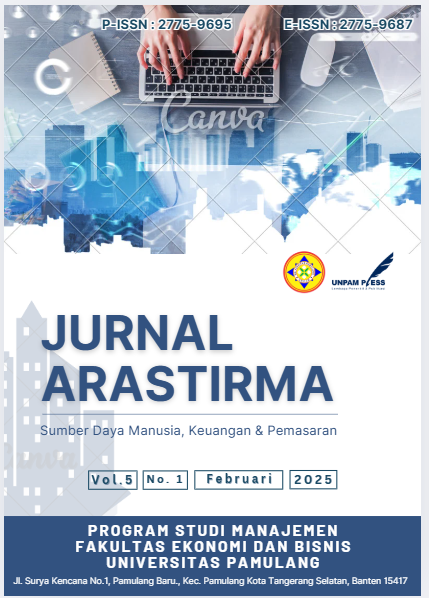Pengaruh Sensory Marketing Terhadap Repurchase Intention Melalui Brand Experience Sebagai Variabel Intervening (Studi Pada KKV Indonesia)
DOI:
https://doi.org/10.32493/jaras.v5i1.46335Keywords:
Sensory Marketing, Brand Experience, Repurchase Intention, KKV IndonesiaAbstract
Tujuan. Penelitian ini bertujuan untuk mengetahui pengaruh sensory marketing terhadap repurchase intention melalui brand experience sebagai variabel intervening pada brand KKV Indonesia
Metode. Penelitian ini menggunakan metode kuantitatif dengan pengumpulan data primer melalui kuesioner yang diperoleh dari responden. Responden dalam penelitian ini adalahh konsumen yang pernah membeli produk KKV Indonesia. Analisis data akan dilakukan menggunakan Structural Equation Modelling - Partial Least Square (SEM-PLS).
Hasil. Hasil dari penelitian ini adalah terdapat pengaruh antara sensory marketing, brand experience, dan repurchase intention
Implikasi. Implikasi praktis dari penelitian ini akan membantu perusahaan dalam merancang strategi pemasaran yang lebih efektif untuk meningkatkan loyalitas konsumen dan keberhasilan merek
References
Alhazmi, A., & Khan, S. (2021). The Role of Sensory Marketing in Influencing the Consumers’ Purchase Patterns-Palarch’s. In Journal of Archaeology of Egypt/Egyptology (Vol. 18, Issue 16).
Aljumah, A. I., Nuseir, M. T., & El Refae, G. A. (2022). The effect of sensory marketing factors on customer loyalty during Covid 19: Exploring the mediating role of customer satisfaction. International Journal of Data and Network Science, 6(4), 1359–1368. https://doi.org/10.5267/j.ijdns.2022.5.015
Amarulloh, A. (2023). Pengaruh sensory marketing terhadap repurchase intention melalui brand experience sebagai variabel intervening (studi pada followers instagram @rotio.indonesia).
Brakus, J., Schmitt, B. H., Zarantonello, L., & Simon, W. E. (2009). Brand Experience: What Is It? How Is It Measured? Does It Affect Loyalty? Journal of Marketing, 73, 1547–7185.
Ekaputri, A. H., Rahayu, A., & Wibowo, L. A. (2016). The Effect of Brand Experience on Customer Satisfaction and The Impact toward Repurchase Intention.
Huaman-Ramirez, R., & Merunka, D. (2019). Brand experience effects on brand attachment: the role of brand trust, age, and income. European Business Review, 31(5), 610–645. https://doi.org/10.1108/EBR-02-2017-0039
Hussain, K., Fayyaz, M. S., Shamim, A., Abbasi, A. Z., Malik, S. J., & Abid, M. F. (2024). Attitude, repurchase intention and brand loyalty toward halal cosmetics. Journal of Islamic Marketing, 15(2), 293–313. https://doi.org/10.1108/JIMA-08-2022-0210
Jang, H. W., & Lee, S. B. (2019). Applying effective sensory marketing to sustainable coffee shop business management. Sustainability (Switzerland), 11(22). https://doi.org/10.3390/su11226430
Kamil, H. A., Sari, A., & Ambarwati, D. A. S. (2023). The Effect of Sensoric Marketing on McDonald’s Consumer Repurchase Intention in Bandar Lampung City with Customer Satisfaction as Mediation Variable. International Journal of Scientific Multidisciplinary Research, 1(6), 547–562. https://doi.org/10.55927/ijsmr.v1i6.5259
Khan, I., & Rahman, Z. (2015). Brand experience anatomy in retailing: An interpretive structural modeling approach. Journal of Retailing and Consumer Services, 24(C), 60–69. https://doi.org/10.1016/j.jretconser.2015.02.003
Khan, M. A., Panditharathna, R., & Bamber, D. (2015). European Journal of Management and Marketing Studies ONLINE STORE BRAND EXPERIENCE IMPACTING ON ONLINE BRAND TRUST AND ONLINE REPURCHASE INTENTION: THE MODERATING ROLE OF ONLINE BRAND ATTACHMENT. European Journal of Management and Marketing Studies, 5. https://doi.org/10.5281/zenodo.3668792
Klein, J. F., Falk, T., Esch, F. R., & Gloukhovtsev, A. (2016). Linking pop-up brand stores to brand experience and word of mouth: The case of luxury retail. Journal of Business Research, 69(12), 5761–5767. https://doi.org/10.1016/j.jbusres.2016.04.172
Krishna, A. (2011). Sensory marketing: Research on the Sensuality of Products.
Krishna, A., & Schwarz, N. (2014). Sensory marketing, embodiment, and grounded cognition: A review and introduction. Journal of Consumer Psychology, 24(2), 159–168. https://doi.org/10.1016/j.jcps.2013.12.006
Kumar, S., & Hsieh, J. K. (2024). How social media marketing activities affect brand loyalty? Mediating role of brand experience. Asia Pacific Journal of Marketing and Logistics. https://doi.org/10.1108/APJML-09-2023-0900
Kustiawan, U., & Matupah. (2024). Pengaruh Brand Image, Brand Equity, Brand Love & Store Brand Experience Terhadap Repurchase Innition. Jurnal TADBIR PERADABAN, 4(2).
Le, T. T., Tiwari, A. K., Behl, A., & Pereira, V. (2022). Role of perceived corporate social responsibility in the nexus of perceived cause-related marketing and repurchase intention in emerging markets. Management Decision, 60(10), 2642–2668. https://doi.org/10.1108/MD-08-2021-1122
Moreira, A. C., Fortes, N., & Santiago, R. (2017). Influence of sensory stimuli on brand experience, brand equity and purchase intention. Journal of Business Economics and Management, 18(1), 68–83. https://doi.org/10.3846/16111699.2016.1252793
Muhamad, F., & Alfisyahr, S. R. (2017). Pengaruh Sensory Marketing Terhadap Kepuasan Konsumen dan Repurchase Intention (Survei pada Konsumen Nomu 9 Bites & Beverages di Kota Malang). In Jurnal Administrasi Bisnis (JAB)|Vol (Vol. 50, Issue 5). www.radarmalang.jawapos.com
Nofrialdi, R., & Herfina, M. (2021). Online Shopping Behavior Model: Determining the Factors Affecting Repurchase Intention. Journal of Low Politic and Humanities, 1(2). https://creativecommons.org/licenses/by/4.0/
Ong, C. H., Lee, H. W., & Ramayah, T. (2018). Impact of brand experience on loyalty. Journal of Hospitality Marketing and Management, 27(7), 755–774. https://doi.org/10.1080/19368623.2018.1445055
Perumal, S., Ali, J., & Shaarih, H. (2021). Exploring nexus among sensory marketing and repurchase intention: Application of S-O-R Model. Management Science Letters, 1527–1536. https://doi.org/10.5267/j.msl.2020.12.020
Petit, O., Velasco, C., & Spence, C. (2019). Digital Sensory Marketing: Integrating New Technologies Into Multisensory Online Experience. Journal of Interactive Marketing, 45, 42–61. https://doi.org/10.1016/j.intmar.2018.07.004
Pham, Q. T., Tran, X. P., Misra, S., Maskeliunas, R., & Damaševičius, R. (2018). Relationship between convenience, perceived value, and repurchase intention in online shopping in Vietnam. Sustainability (Switzerland), 10(1). https://doi.org/10.3390/su10010156
Press Release Indonesia. (2024, April 18). Merajut Kesuksesan: Pertumbuhan Penjualan Ritel Terus Memperkuat Ekonomi di Maret 2024. Https://Www.Pressreleaseindonesia.Com/2024/04/Merajut-Kesuksesan-Pertumbuhan.Html.
Rahmawati, F., & Nurhadi. (2024). The Influence of Visual Merchandising, Store Atmosphere, and Sales Promotion on Impulse Buying for KKV Consumers At The Surabaya City Galaxy Mall. 15(2), 259–269. https://doi.org/10.32832/jm-uika.v15i2.16378
Riza, A. F., & Dharmmesta, B. S. (2016). Pengaruh Pemasaran Sensorik Pada Pengalaman Merek Berdasarkan Perspektif Teori Stimulus-Organisme-Respon. Universitas Gadjah Mada.
Riza, A. F., & Wijayanti, D. M. (2018). The Triangle of Sensory Marketing Model: Does it Stimulate Brand Experience and Loyalty? Esensi: Jurnal Bisnis Dan Manajemen, 8(1). https://doi.org/10.15408/ess.v8i1.6058
Roggeveen, A. L., Grewal, D., & Schweiger, E. B. (2020). The DAST Framework for Retail Atmospherics: The Impact of In- and Out-of-Store Retail Journey Touchpoints on the Customer Experience. Journal of Retailing, 96(1), 128–137. https://doi.org/10.1016/j.jretai.2019.11.002
Roopchund Randhir, Khirodhur Latasha, Panyandee Tooraiven, & Bappoo Monishan. (2016). Analyzing the Impact of Sensory Marketing on Consumers: A Case Study of KFC. Journal of US-China Public Administration, 13(4). https://doi.org/10.17265/1548-6591/2016.04.007
Roswinanto, W., & Strutton, D. (2014). Investigating the Advertising Antecedents to and Consequences of Brand Experience. Journal of Promotion Management, 20(5), 607–627. https://doi.org/10.1080/10496491.2014.946206
Sayed, M. S. (2023). The Impact of Sensory Marketing on Managing a Sustainable Fast-Food Business in Egypt.
Sehgal, N., Jham, V., & Malhotra, G. (2023). Does green brand anthropomorphism influence repurchase intention? Understanding the impact of brand warmth, psychological ownership, and self-brand congruity. Journal of Retailing and Consumer Services, 75. https://doi.org/10.1016/j.jretconser.2023.103546
Shahid, S., Paul, J., Gilal, F. G., & Ansari, S. (2022). The role of sensory marketing and brand experience in building emotional attachment and brand loyalty in luxury retail stores. Psychology and Marketing, 39(7), 1398–1412. https://doi.org/10.1002/mar.21661
Soedionon, W., Prasastyo, K. W., & Adeline, M. (2020). Pengaruh Brand Experience, Brand Image-Congruence, Brand Affect dan Brand Trust Terhadap Repurchase Intention Pada Produk Fashion Berrybenka Secara Online Di Jakarta (Vol. 12, Issue 1). http://jurnaltsm.id/index.php/MB
Suara NTB. (2024, February 1). KKV Kini Hadir di Lombok Epicentrum Mall, Ada Gift Menarik untuk Pelanggan. Https://Www.Suarantb.Com/2024/02/01/Kkv-Kini-Hadir-Di-Lombok-Epicentrum-Mall-Ada-Gift-Menarik-Untuk-Pelanggan/.
Sugiyono. (2017). Metode Penelitian Kuantitatif, Kualitatif, dan R&D. CV Alfabeta.
Wei, J., Lian, Y., Li, L., Lu, Z., Lu, Q., Chen, W., & Dong, H. (2023). The impact of negative emotions and relationship quality on consumers’ repurchase intention: An empirical study based on service recovery in China’s online travel agencies. Heliyon, 9(1). https://doi.org/10.1016/j.heliyon.2023.e12919
Wiedmann, K. P., Labenz, F., Haase, J., & Hennigs, N. (2018). The power of experiential marketing: Exploring the causal relationships among multisensory marketing, brand experience, customer perceived value and brand strength. Journal of Brand Management, 25(2), 101–118. https://doi.org/10.1057/s41262-017-0061-5
Wu, L. Y., Chen, K. Y., Chen, P. Y., & Cheng, S. L. (2014). Perceived value, transaction cost, and repurchase-intention in online shopping: A relational exchange perspective. Journal of Business Research, 67(1), 2768–2776. https://doi.org/10.1016/j.jbusres.2012.09.007
Downloads
Published
How to Cite
Issue
Section
License
Copyright (c) 2025 Rachman Indera Permana, Avenita Regita Kristi

This work is licensed under a Creative Commons Attribution 4.0 International License.
Penulis yang menerbitkan jurnal ini menyetujui persyaratan berikut:
Penulis memiliki hak cipta artikel dan menyerahkan kepada jurnal hak publikasi pertama dengan karya yang secara simultan dilisensikan di bawah di bawah persyaratan Atribusi 4.0 Internasional (CC BY 4.0)
 yang memungkinkan orang lain untuk berbagi karya dengan pengakuan kepengarangan karya dan publikasi awal dalam jurnal ini.
yang memungkinkan orang lain untuk berbagi karya dengan pengakuan kepengarangan karya dan publikasi awal dalam jurnal ini.Penulis dapat masuk ke dalam pengaturan kontrak tambahan yang terpisah untuk distribusi non-eksklusif versi jurnal yang diterbitkan dari karya tersebut (misalnya, mempostingnya ke repositori institusional atau menerbitkannya dalam sebuah buku), dengan pengakuan atas karya awalnya publikasi dalam jurnal ini.
Penulis diizinkan dan didorong untuk memposting pekerjaan mereka secara online (misalnya, dalam repositori institusional atau di situs web mereka) sebelum dan selama proses pengajuan, karena dapat menyebabkan pertukaran yang produktif, serta kutipan yang lebih awal dan lebih besar dari karya yang diterbitkan (Lihat The Effect of Open Access).







